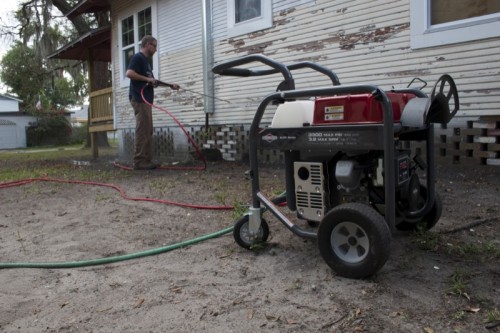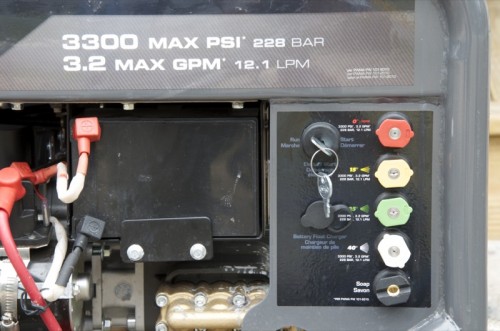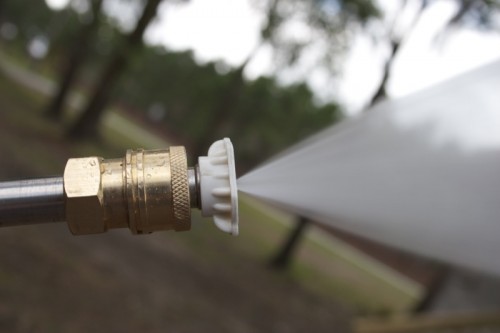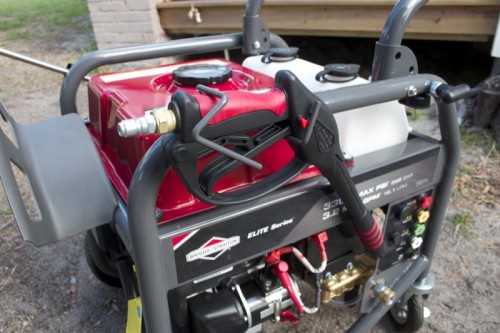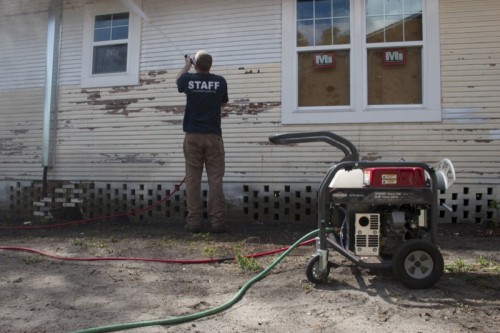Many of the tools we review at PTR end up being tested and used on inner-city work projects. This is because several of the writers are involved in Parker Street Ministries, a downtown non-profit organization focused on neighborhood revitalization and restoration. We also just enjoy being able to give back to the community. When we got a Briggs & Stratton Elite 3300 psi pressure washer in for review, we knew exactly how we’d test it. One of the projects we’ve been working on this year is the renovation of two early 1900’s bungalows, homes that have been mentioned in other articles in this and other PTR issues. These historic era homes have tons of character, and the renovation work includes everything from siding and windows to moving walls and of course painting.
Briggs & Stratton 3300 PSI Pressure Washer Testing
To make sure we gave the Briggs & Stratton a thorough and fair review, we brought in our friend Richard Nicholson, a professional painter with 35 years of experience under his belt. He got to use the pressure washer to prep our renovated homes for painting and was kind enough to give us his feedback in the process.
Pro Tool Reviews (PTR): Rick, thanks for taking point on this review. Before we dive in, can you tell me a little bit about your background? What do you do, and how long have you been doing it?
Richard Nicholson (Rick): I’ve been a professional painter for around 35 years now. That pretty much means I’ve been using a pressure washer the whole time. I’d guess I’ve been through roughly 5 or 6 of them. Most of those were Hondas.
PTR: So do you do a lot of work on older homes?
Rick: What I specialize in are very old homes. Wood siding, wood frame. Mostly turn of the century stuff—that would be the 20th century!
PTR: Got it. What’s the main challenge you find in painting homes?
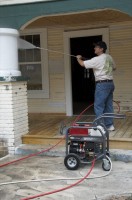
PTR: You got to use the Briggs & Stratton Elite 3300 for this project. What did you first notice about this pressure washer?
Rick: The electric start is definitely nice. That, and the safety button on the handle is a worthy feature. You can’t pull the trigger accidentally, but once you release it, it’s got a pretty soft trigger. In effect, the safety for this tool is two-stage, whereas on other models the trigger pull is simply harder. With the separate safety, I found the wand easier to use and control.
The 3300 has the specs right next to where the tips store on the side of the pressure washer. I’ve been doing this for 35 years, and I still forget all but two or three of them. The quick reference was nice to have on the side of the pressure washer.
I also liked the two self-contained [1 gallon] solution reservoirs. They are actually built right into the pressure washer, which is pretty cool. You could, for example, switch between soap and bleach, and the amounts can be regulated using the control underneath. With that, you can dial it back so that you don’t blow through all of it too quickly. The way it’s set up you can use undiluted solutions because the Briggs & Stratton will mix it for you with the incoming water. It just makes everything simpler and you can avoid carrying around a bucket and a siphon adapter. You also get the added benefit of not having to shut down the system and release the pressure to take it off. So you can imagine, having the self-contained system is rather nice.
As I mentioned, I usually just use sodium hypochlorite, which is pool chlorine. (I have jugs of it.) I’m typically cleaning in preparation for painting as opposed too just washing off a house. So, in my case, I get to have two gallons of chlorine all set to mix into my spray as needed. Afterward, I make sure to run water through the system to clean everything off and avoid premature wear. I don’t think pressure washer companies like chlorine and it may even void some warranties, but there are a lot of us who’ve been doing it for years anyway.
PTR: How about the performance of the pressure washer during use?
Rick: It had really high pressure, and it was nice that it came with five tips in all of the varying degrees of spray that I’d expect. The wand has a comfortable pistol grip handle and a secondary hand rest for your other hand, which I used a lot. I always seem to end up doing a lot overhead and the secondary grip helps me to balance the wand and better control my spraying.
At 3300 psi it’s powerful. Once I primed it, it ran nice and smooth and was easy to move around. The hose caddy was a helpful feature and it kept everything organized. It’s just a thoughtful design and one that I definitely got a lot of use out of.
Using Your Pressure Washer for the First Time
The first time you use any pressure washer you want to make sure you pick up some silicone grease and lube up the o-rings and any of the fittings you’ll be putting together. It prolongs the life of your fittings and it will keep you from scoring the o-rings when you slide the hose and wand together. I picked up some Harvey’s brand grease and it seemed to do the trick.
PTR: So how does the Briggs and Stratton compare to those Honda’s you’ve used for years?
Rick: In the past, I pretty much just relied on the vendor to recommend a product.
PTR: Hey, what about reviews!?
Rick: Well, your magazine wasn’t around back then!
PTR: Touché.
Rick: I think that when I use a pressure washer, what I care about is that it starts easily. Most of mine have been manual pull-starts, so that’s been really important—that they crank. I also want to make sure they can run 150-200 feet of hose. I’ve done some fairly large buildings, and that can be really demanding. I also want them easy to maneuver. That’s pretty much the big stuff. These tools might be complex on the inside, but they should be easy for the operator to control so he can get his work done.
Also, I look for it to have good grab handles so I can lift it up into the truck and move it around easily on rougher job sites. The Briggs & Stratton 3300 has the four wheels, and since even the fronts are 5″ in diameter, I could pull it over tree roots and bumpy sod with no real issues. I had one a while back that was just way too big, so now I appreciate a more compact pressure washer that still has the power I need.
PTR: Is there anything you’d change about the 3300?
Rick: The biggest problem I’ve had in the past is when I’ve wanted to use an extension wand to reach higher locations. A six-foot or twelve-foot wand can let you do a two-story building from the ground or a short step ladder. But, if you don’t have a wand that lets you decouple right at the trigger, then you have a coupler that’s hanging 3′ out in space. That’s a common point of failure due to the stress put on it and lack of support.
It would be cool if Briggs & Stratton reworked their wand so that you could more easily flip out the lengths without having to couple three feet down the wand. On a positive note, I’m pretty sure I could purchase a third party coupling and affix it to the base of the wand to get what I’m looking for. If I was having to switch back and forth for this job I’d have done just that.
PTR: What else would you do with this type of pressure washer?
Rick: With a driveway scrubber accessory, the Briggs & Stratton would do a great job at that type of task. That’s where you can put on this two-handle floor scrubber-type attachment. It has about an 18″ diameter housing that has two tips in it, both at opposing angles. The wand spins really fast and is able to cover a swath 18″ wide in just a few seconds. This is as opposed to taking a small spray tip and going back and forth on your driveway. Invariably you end up leaving lines on the concrete.
PTR: You mentioned portability. What did you think of the 3300 from that perspective?
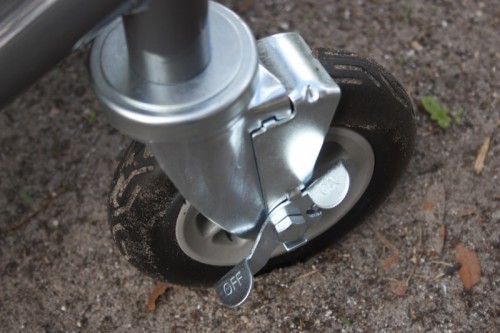
The bigger real wheels are hard rubber, and while I actually prefer air-filled, I do know that with these you’re not going to have to deal with issues of them going flat. Sometimes, in the past, I’ve found the hard wheels ended up being more like a “plow” in how they go across the turf. Apparently they’re making them a lot better these days because the 3300 held its own pretty well.
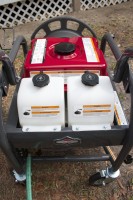
Rick: Oh, yeah. The older I get, the more I think I’ll take any advantage I can find! My Honda’s typically start on the first pull, but that’s still extra manual effort. The rope can brake, the clutch on the inside can mess up…with an electric start you can just fire that baby up. When the engine’s cold, it’s nice to just turn the choke and twist the key. I’d definitely pay more for that feature.
PTR: So what’s your next project?
Rick: It kinda looks like volunteering over there with you guys and painting these historic homes. I’m also going over to another beautiful house in a different section of the downtown area. That one just needs some prep work, and then I can hopefully just spray it.
Come to think of it…it might be another great opportunity to use this pressure washer!
If you’ve got a project story you’d like to share with us, please email it to us at editor AT protoolreviews.com and we can consider using it in a future article or contacting you to get more information.
Tradesman Profile: Richard Nicholson
A professional painter for over 35 years, Richard Nicholson specializes in the restoration and renovation of historic homes in Lakeland, Florida, where his professional painting expertise can be seen all over the city. He’s also an avid reader and enjoys taking the time to do the job right the first time.


